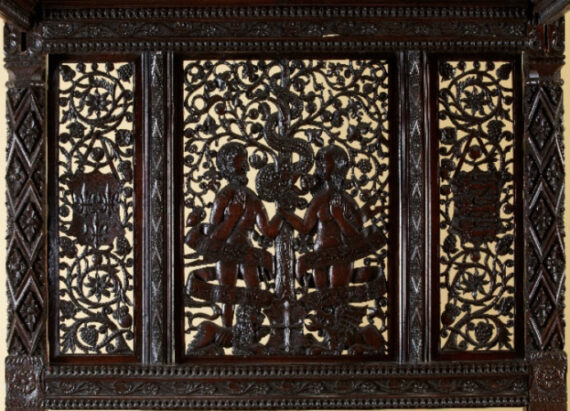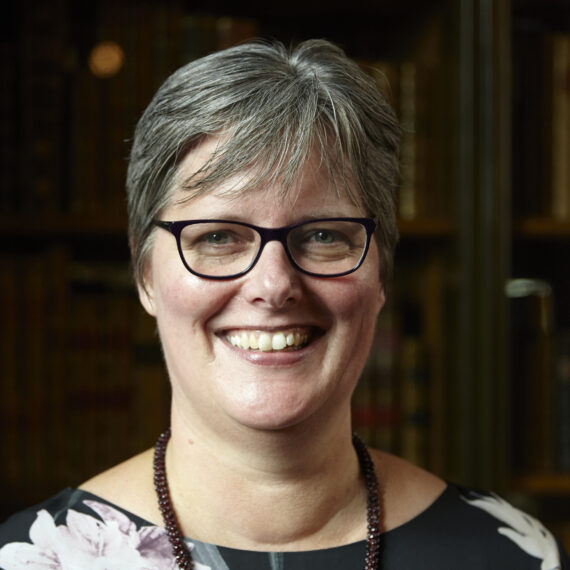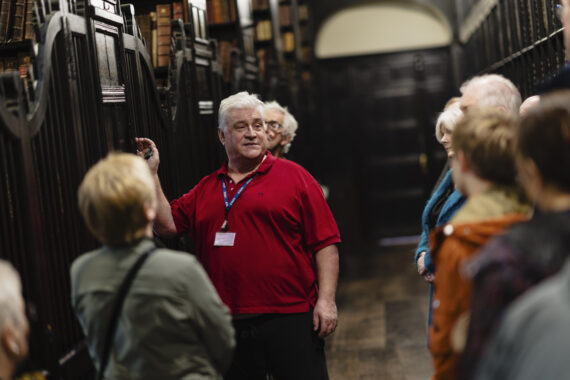A Royal Tudor Bed and a Northern Rogue
1 CommentVisitors to Manchester have the rare opportunity to see the original marriage bed made for Henry VII (the first Tudor King) and Elizabeth of York, as well as an infamous forgery, this summer.
This new exhibition, A Royal Tudor Bed and a Northern Rogue, will be hosted at Chetham’s Library from 15 August – 11 September.
The original four-poster bed was made in 1485 for Henry and Elizabeth who married the following year. Their marriage united two conflicting families, the Yorkists and the Lancastrians, who had been at war for 30 years. Henry recognised the importance of taking a Yorkist bride, to strengthen his claim to the throne and to weaken any other Yorkist’s claim.
The bed is a hugely important piece of history as it marks the end of the War of the Roses and the beginnings of the Tudor dynasty, and its headboard is dense with symbols of unity, redemption, fertility, and new beginnings.
George Shaw (1810–76), a ‘rogue’ from Saddleworth, was fascinated by medieval architecture and he created mock Tudor and Elizabethan furniture for the Duke of Northumberland, the Earls of Bradford and Derby, the Towneleys and Bagshawes, and Chetham’s Library. A lectern in Manchester Cathedral is also by George Shaw. Shaw created a replica of the Tudor marriage bed, which will be on display as part of this new exhibition.
Peter Lindfield, Historian and Cardiff University Lecturer, said: “The original Tudor bed tells an incredible story of royalty, war, politics, and marriage in the 1400s; but Shaw’s copy tells an equally riveting tale of forgery, as well as 19th century politics and business. At its peak, Shaw’s Uppermill workshop employed more than one hundred people. I can’t wait for people in Manchester to experience the exhibit.”
Ian Coulson, from The Langley Collection and who discovered the bed, said: “I suspected the bed had late 15th – early 16th century origins after observing the shrinkage, infestation, oxidation and complex history of loss and repair that the bed had suffered. What followed was several years of multi-disciplinary investigation that revealed the identity as the long-lost marriage bed of Henry VII and Elizabeth of York. It’s an incredible piece of history that I hope many people will enjoy.”
The exhibition will be available to see as part of Chetham’s Library’s regular tours from Thursday 15 August – Wednesday 11 September. The tour includes the opportunity to explore the rest of our unique Library, the oldest in the UK, and see more of George Shaw’s furniture.
There will also be a series of free talks exploring the exhibition running through August and September. Find out more and book your tickets at the links below:
The First Tudor bed: Discovery and Comparison with Ian Coulson, Thursday 22 August, 5.30pm
The Duke, the Forger and the Mystery Blue, with Helen Hughes Wednesday 28 August, 5.30pm
Maker and Faker of ‘ancient Tudor relics’: George Shaw of Uppermill with Dr Peter N. Lindfield Wednesday 4 September, 5.30pm
Exhibition Closing: Henry VII’s and Elizabeth of York’s Marriage Bed and Manchester Wednesday 11 September, 5.30pm
Click for the full exhibition information.



